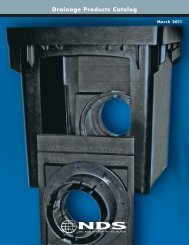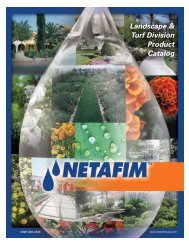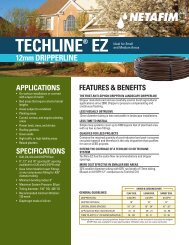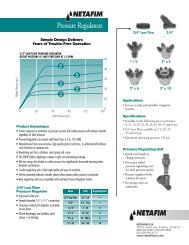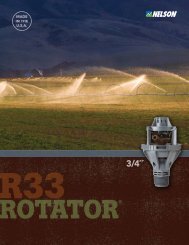PRODUCT GUIDE - K-Rain
PRODUCT GUIDE - K-Rain
PRODUCT GUIDE - K-Rain
You also want an ePaper? Increase the reach of your titles
YUMPU automatically turns print PDFs into web optimized ePapers that Google loves.
WIRE SIZING<br />
RESISTANCE METHOD<br />
Required Information<br />
■ Actual one-way length of wire between the controllers<br />
and at the power source of the controllers and valves<br />
■ Allowable voltage loss along the wire circuit<br />
■ Accumulative current flowing through the wire section<br />
being sized in amperes<br />
Resistance is calculated using formula:<br />
R= 1000 x AVL<br />
2L x I<br />
R = Maximum Allowable Resistance<br />
of wire in ohms per 1000 feet<br />
AVL= Allowable voltage loss<br />
L= Wire length (one way)<br />
I= Inrush current<br />
AVL for controller power wire sizing is calculated by<br />
subtracting the minimum operating voltage required<br />
by the controller from the minimum available voltage<br />
at the power source.<br />
TABLE 1<br />
Resistance of Copper Wire<br />
WIRE SIZE Resistance at 20° C (68° F)<br />
AWG No. ohms per 1000 Feet<br />
18 6.39<br />
16 4.02<br />
14 2.52<br />
12 1.59<br />
10 1.00<br />
8 0.63<br />
6 0.40<br />
4 0.25<br />
FORMULAS<br />
AVL for valve wire sizing is calculated by subtracting<br />
minimum solenoid operating voltage from controller<br />
output voltage. This number will vary depending on the<br />
manufacturer and in some cases with line pressure.<br />
VALVE WIRE SIZING EXAMPLE:<br />
Given: The distance from the controller to the valve is 1800 ft.<br />
The controller output is 24V. The valve has a minimum operating<br />
voltage of 20V and an inrush current of 370 mA (0.37Amps).<br />
R = 1000 x 4<br />
2(1800) x 0.37<br />
R = 4000<br />
1332<br />
R = 3.00 ohms/1000 feet<br />
Wire resistance can not exceed 3.00 ohms per 1000 feet.<br />
Go to table #1 and select the proper wire size. Since 16<br />
gauge wire has more resistance that 3.00 ohms per 1000<br />
feet, choose 14 gauge wire.<br />
Table 2 is a quick reference and is set up to provide maximum<br />
wire runs given the information at the bottom of the table.<br />
PRECIPITATION RATES (U.S.) (METRIC)<br />
Equilateral Triangular P.R.= (GPM of 360) x 96.25 P.R.= m3/hr of 360 x 1000<br />
Spacing (in/hr) (Head Spacing) 2 x .866 (mm/hr) m2 x .866<br />
Square/Rectangular P.R.= (GPM of 360) x 96.25 P.R.= m3/hr of 360 x 1000<br />
Spacing (in/hr) head Spacing x Row Spacing (mm/hr) Degrees of Arc x Head Spacing<br />
Square/Rectangular P.R.= 3460 x GPM (for any arc) P.R.= m3/hr (for any arc) x 1000<br />
Spacing for Specific Arc (in/hr) Degrees of Arc x Head Spacing x Row Spacing (mm/hr) Degrees of Arc x Head Spacing x Row Spacing<br />
Horsepower H.P. = GPM x Ft of Head<br />
3,960 x Pump Efficiency (expressed as a decimal)<br />
TABLE 2<br />
Valve Wire Sizing (Maximum One-Way Distance in Feet Between Controller and Valve)<br />
GROUND<br />
CONTROL WIRE<br />
WIRE 18 16 14 12 10 8 6<br />
18 850 1040 1210 1350 1460 1540 1590<br />
16 1040 1340 1650 1920 2150 2330 2440<br />
14 1210 1650 2150 2630 3080 3450 3700<br />
12 1350 1920 2630 3390 4170 4880 5400<br />
10 1460 2150 3080 4170 5400 6670 7690<br />
8 1540 2330 3450 4880 6670 8700 10530<br />
6 1590 2440 3700 5400 7690 10530 13330<br />
Solenoid: 24VAC, Pressure: 150 PSI, Voltage Drop: 4V, Min. Operating Voltage: 20V, Amperage Peak: .37A<br />
Station Run Time S.R.T. = Total Weekly Req’d (inch/wk) x 60 (min/hr) S.R.T.= Total Weekly Req’d (mm/wk) x 60 (min/hr)<br />
(min/wk) Precipitation Rate (in/hr) (min/wk) Precipitation Rate (mm/hr)<br />
ROTORS<br />
SPRAY HEADS ELECTRIC VALVES CONTROLLERS INDEX VALVES / RCW CHARTS<br />
Pipe Velocity V= 0.4085 x Flow (GPM) V= 1273.24 x Fl0flow (l/sec)<br />
(ft/sec) (Inside Pipe Diameter in Inches) 2 (m/sec) (Inside Pipe Diameter in Millimeters) 2<br />
Scheduling Coefficient S.C.= Average Precipitation Rate (in/hr) S.C.= Average Precipitation Rate (mm/hr)<br />
Lowest PRecipitation Rate (in/hr)<br />
Lowest Precipitation Rate (mm/hr)<br />
Slope S= Rise (Measure of Length)<br />
Run (Measure of Length)<br />
47




